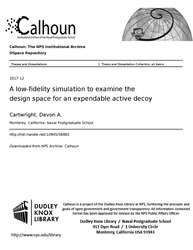File:A low-fidelity simulation to examine the design space for an expendable active decoy (IA alowfidelitysimu1094556882).pdf

Original file (1,275 × 1,650 pixels, file size: 2.6 MB, MIME type: application/pdf, 100 pages)
Captions
Captions
Summary
[edit]| A low-fidelity simulation to examine the design space for an expendable active decoy
( |
||
|---|---|---|
| Author |
Cartwright, Devon A. |
|
| Title |
A low-fidelity simulation to examine the design space for an expendable active decoy |
|
| Publisher |
Monterey, California: Naval Postgraduate School |
|
| Description |
A new type of expendable radar decoy, one that leverages the advances in technology of the last 50 years, is required to improve the survivability of non-stealth aircraft against radar-guided threats. This thesis applies modeling and simulation based systems engineering to explore the design space of a notional active expendable decoy to determine the combination of key performance parameters that will maximize probability of survival. The thesis focuses on development of a Microsoft Excel-based simulator, which accepts inputs from the user, uses a nearly orthogonal Latin hypercube experimental design, and performs multiple simulator runs with stochastic model variables. The final output includes statistical analysis of results to provide the user with the best combination of design variables to improve survivability against specified threat parameters. Results show that either low power with high gain, or high power with low gain, was the best combination for maximizing probability of survival. In addition, low altitude deployments are to be avoided unless the missile is very near the target aircraft. The results provided by the tool are notional, based on realistic approximations of radar, aircraft, and decoy systems. The results will inform the acquisition strategy of NAVAIR. Subjects: expendable active decoy; EAD; radar countermeasures; modeling and simulation based systems engineering; MSBSE |
|
| Language | English | |
| Publication date | December 2017 | |
| Current location |
IA Collections: navalpostgraduateschoollibrary; fedlink |
|
| Accession number |
alowfidelitysimu1094556882 |
|
| Source | ||
| Permission (Reusing this file) |
This publication is a work of the U.S. Government as defined in Title 17, United States Code, Section 101. Copyright protection is not available for this work in the United States. | |
Licensing
[edit]| Public domainPublic domainfalsefalse |
This work is in the public domain in the United States because it is a work prepared by an officer or employee of the United States Government as part of that person’s official duties under the terms of Title 17, Chapter 1, Section 105 of the US Code.
Note: This only applies to original works of the Federal Government and not to the work of any individual U.S. state, territory, commonwealth, county, municipality, or any other subdivision. This template also does not apply to postage stamp designs published by the United States Postal Service since 1978. (See § 313.6(C)(1) of Compendium of U.S. Copyright Office Practices). It also does not apply to certain US coins; see The US Mint Terms of Use.
|
 | |
| This file has been identified as being free of known restrictions under copyright law, including all related and neighboring rights. | ||
https://creativecommons.org/publicdomain/mark/1.0/PDMCreative Commons Public Domain Mark 1.0falsefalse
File history
Click on a date/time to view the file as it appeared at that time.
| Date/Time | Thumbnail | Dimensions | User | Comment | |
|---|---|---|---|---|---|
| current | 03:59, 14 July 2020 |  | 1,275 × 1,650, 100 pages (2.6 MB) | Fæ (talk | contribs) | FEDLINK - United States Federal Collection alowfidelitysimu1094556882 (User talk:Fæ/IA books#Fork8) (batch 1993-2020 #5978) |
You cannot overwrite this file.
File usage on Commons
The following page uses this file:
Metadata
This file contains additional information such as Exif metadata which may have been added by the digital camera, scanner, or software program used to create or digitize it. If the file has been modified from its original state, some details such as the timestamp may not fully reflect those of the original file. The timestamp is only as accurate as the clock in the camera, and it may be completely wrong.
| Short title | A low-fidelity simulation to examine the design space for an expendable active decoy |
|---|---|
| Author | Cartwright, Devon A. |
| Date and time of digitizing | 23:37, 14 December 2017 |
| Software used | Microsoft® Word 2016 |
| File change date and time | 04:38, 16 January 2018 |
| Date metadata was last modified | 04:38, 16 January 2018 |
| Conversion program | Microsoft® Word 2016 |
| Encrypted | no |
| Page size |
|
| Version of PDF format | 1.4 |

